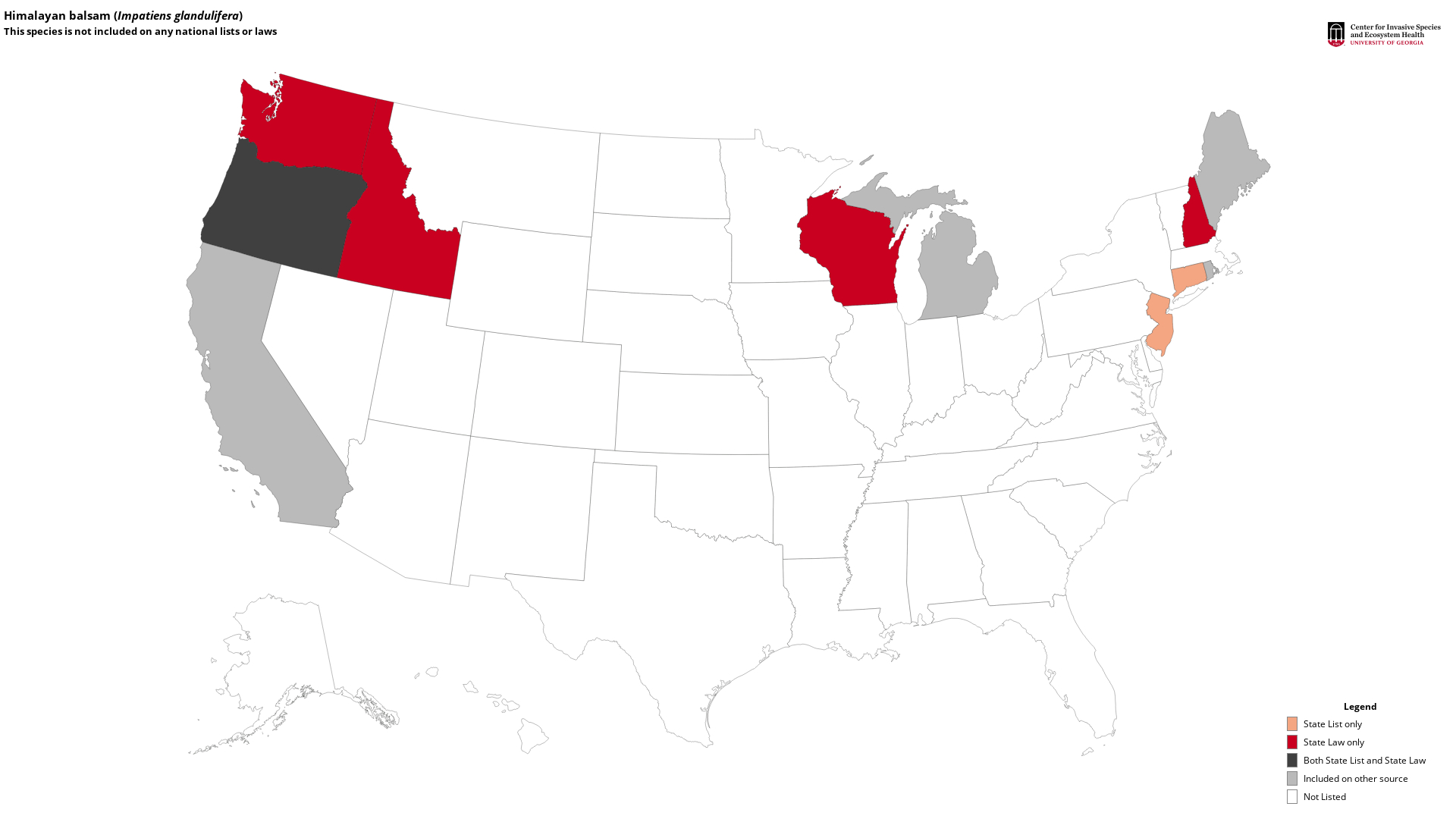Himalayan balsam
(Impatiens glandulifera)
This species is Introduced in the United States
Appearance
Impatiens glandulifera is a succulent annual that can be 3-10 ft. (0.9-3 m) tall. The stems are purple-tinged, hollow, and hexagonally angled.
Foliage
The foliage is opposite or whorled. Leaves are lanceolate to lance-ovate with acuminate tips. Leaves are simple, serrate and 6 in. (15.2 cm) long.
Flowers
Flowering occurs from June to October. The pink, irregular, solitary flowers appear on axillary stalks.
Fruit
Fruits are five chambered capsules that, when mature, explode expelling seeds forcefully. Each plant produces about 800 seeds.
Ecological Threat
Impatiens glandulifera occurs in areas with high soil moisture, such as riparian areas. It is tall for an annual plant, has a fast growth rate, reseeds aggressively, and outcompetes native vegetation. Plants are partially shade tolerant. It is native to India.
Citations
Rawlins, K.A., R.L. Winston, C.T. Bargeron, D.J. Moorhead, and R. Carroll. 2018. New Invaders of the Northeast and Northcentral United States. USDA Forest Service, Forest Health Assessment and Applied Sciences Team, Morgantown, West Virginia. FHTET-2017-04. Retrieved from https://bugwoodcloud.org/resource/pdf/FHTET-2017-04_New%20Invaders_NE.pdf
Winston, R.L., Andreas, J.E., Milan, J., DesCamp, W., Randell, C.B., and M. Schwarzländer. 2014. New Invaders of the Northwest. United States Department of Agriculture, Forest Health Technology Enterprise Team. FHTET-2014-12. Retrieved from https://www.fs.fed.us/foresthealth/technology/pdfs/FHTET-2014-12_NW_New_Invaders.pdf
Impatiens glandulifera is a succulent annual that can be 3-10 ft. (0.9-3 m) tall. The stems are purple-tinged, hollow, and hexagonally angled.
Foliage
The foliage is opposite or whorled. Leaves are lanceolate to lance-ovate with acuminate tips. Leaves are simple, serrate and 6 in. (15.2 cm) long.
Flowers
Flowering occurs from June to October. The pink, irregular, solitary flowers appear on axillary stalks.
Fruit
Fruits are five chambered capsules that, when mature, explode expelling seeds forcefully. Each plant produces about 800 seeds.
Ecological Threat
Impatiens glandulifera occurs in areas with high soil moisture, such as riparian areas. It is tall for an annual plant, has a fast growth rate, reseeds aggressively, and outcompetes native vegetation. Plants are partially shade tolerant. It is native to India.
Citations
Rawlins, K.A., R.L. Winston, C.T. Bargeron, D.J. Moorhead, and R. Carroll. 2018. New Invaders of the Northeast and Northcentral United States. USDA Forest Service, Forest Health Assessment and Applied Sciences Team, Morgantown, West Virginia. FHTET-2017-04. Retrieved from https://bugwoodcloud.org/resource/pdf/FHTET-2017-04_New%20Invaders_NE.pdf
Winston, R.L., Andreas, J.E., Milan, J., DesCamp, W., Randell, C.B., and M. Schwarzländer. 2014. New Invaders of the Northwest. United States Department of Agriculture, Forest Health Technology Enterprise Team. FHTET-2014-12. Retrieved from https://www.fs.fed.us/foresthealth/technology/pdfs/FHTET-2014-12_NW_New_Invaders.pdf
Selected Images
Maps
EDDMapS Distribution - This map is incomplete and is based only on current site and county level reports made by experts, herbaria, and literature. For more information, visit www.eddmaps.org
State Lists - This map identifies those states that have this species on their invasive species list or law.
Invasive Listing Sources
- Alberta Fisheries Act
- Alberta Weed Control Act
- California Invasive Plant Council
- Connecticut Invasive Plant List
- Connecticut Invasive Plant Working Group
- Idaho Noxious Weeds
- Maine Invasive Plants
- Michigan’s Invasive Species Watch List
- Mid-Atlantic Field Guide to Aquatic Invasive Species
- National Park Service, Mid-Atlantic Exotic Plant Management Team Invasive Plant List
- Native Plant Society of Oregon, 2008
- New Hampshire Prohibited Invasive Species
- New Invaders of the Northeast and Northcentral
- New Invaders of the Northwest
- New Jersey Invasive Species Strike Team 2017 Invasive Species List
- Ontario’s Invading Species Awareness Program Tracked Species List
- Oregon Noxious Weeds
- Pacific Northwest Exotic Pest Plant Council, 1998
- Rhode Island Natural History Survey
- To be proposed for MISC
- Washington Noxious Weeds
- WeedUS - Database of Plants Invading Natural Areas in the United States
- Wisconsin Noxious Weeds
- Wisconsin's Invasive species rule – NR 40
Taxonomic Rank
| Domain: Eukarya |
| Kingdom: Plantae |
| Phylum: Magnoliophyta |
| Class: Magnoliopsida |
| Superorder: Asteranae |
| Order: Ericales |
| Family: Balsaminaceae |
| Genus: Impatiens |
| Impatiens glandulifera |
References
Common Name Reference: USDA, NRCS. 2010. The PLANTS Database. National Plant Data Center, Baton Rouge, LA, USA.
Scientific Name Reference: USDA, NRCS. 2010. The PLANTS Database. National Plant Data Center, Baton Rouge, LA, USA.


